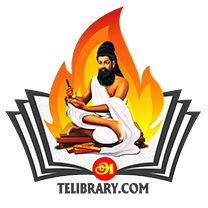

The Tamil Eelam medical team operated much like Cuba’s healthcare system
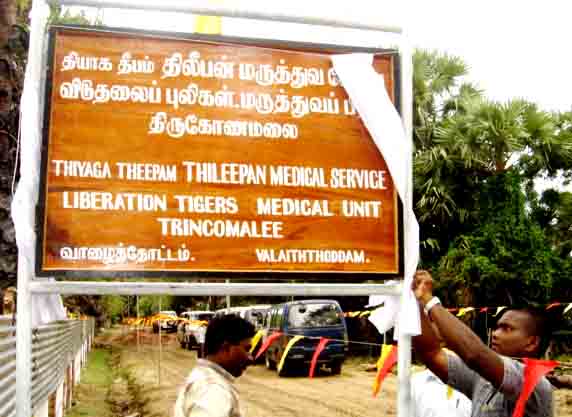
You worked as a doctor and a combatant in our struggle until the very end. What are your thoughts on your role?
I am filled with a sense of fulfillment that, as a medical combatant, I was able to save many lives from the genocidal actions imposed on our people by Sinhalese supremacy. I performed my duties as a doctor with utmost dedication. I served the people as a doctor in the administrative unit of the Thiyaga Theepam Thileepan Hospital.
The Purpose of Thileepan Hospital
Thiyaga Theepam Hospital was conceived from the visionary ideas of the National Leader of Tamil Eelam. It was created as a healthcare division dedicated to the people, symbolizing the Tamil Eelam Liberation Tigers. The hospital’s primary goal was to meet the basic medical needs wherever required. It was structured to serve rural areas, providing essential healthcare services to the people.
How was the foundation for this laid?
Although it’s challenging to pinpoint a specific starting point, rural healthcare initiatives have existed since the early days of the Tamil Eelam liberation struggle. Numerous examples can be cited:
- The Suthanthirappiravaikal organization worked to fulfill the medical needs of the people, spreading medical awareness and offering basic assistance during the early phases of the liberation movement.
- Early efforts by senior combatant doctors like Dr. Elumathi Karikalan included the publication of materials such as First Aid During Wartime, a manual for the people.
Simultaneously, as the medical division began to address the needs of the fighters, the requirements of the civilian population were also recognized. When the Tamil Eelam Medical College was established, students training there were guided with clarity by the Leader himself. Their education reflected his vision, enabling them to serve the people effectively until the silent end of the liberation movement at Mullivaikkal.
Additionally, even in the early days of the medical division, female combatant doctor Deva and her team provided mobile healthcare services to villages.
Why was this named after Thiyaga Theepam Thileepan?
This was a decisive decision by the Leader. It might be linked to the fact that the Suthanthirappiravaikal organization, under Thileepan’s leadership, initially carried out such tasks. It could also be due to Thileepan’s transition from a medical student to a revolutionary fighter, or perhaps his memorable words asking that his body be used for medical studies following the tragic death of Veera Cha.
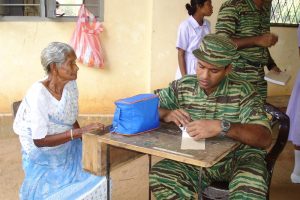
When was Thileepan Hospital established?
The formal structure of Thiyaga Theepam Thileepan Hospital was developed around 2001. While medical combatants had been serving the people prior to that, those efforts were primarily carried out by combatant doctors under the Tamil Eelam Health Services. Thileepan Hospital as an institution was formed during this period. Initially, we began with mobile healthcare services. Through these, we addressed public awareness programs, epidemic prevention measures, and treatments for snake and poison bites. The operations began by identifying villages through the Rural Development Department of the Political Wing.
The first official service under this structure started in the village of Poothanvayal. From there, we gradually expanded to other villages.
In 2002, the hospital was established as a medical facility with buildings. In Karisilai Madu, the first hospital was inaugurated by Brigadier Tamilchelvan, who was then the head of the Tamil Eelam Political Wing. The nameplate was unveiled by Dr. Suriyakumaran. The first doctor in charge of this facility was female combatant doctor Vasanthimala.
Why were Thileepan Hospital’s activities focused on rural areas?
The hospital’s mission was to establish basic healthcare facilities for the rural population. In urban areas, adequate medical facilities were already available. However, rural areas lacked such access.
For the Tamil Eelam region, especially Vanni, the population density was relatively low. Consequently, the government did not establish basic healthcare centers in all villages, as their medical department prioritized population-based resource allocation.
In such circumstances, rural residents had to endure great hardships, often traveling long distances for medical care. Therefore, we sought to provide services wherever there was a need.
Who were the people working here?
In truth, everyone involved were combatants, shaped by the National Leader’s vision. They were steadfast in fulfilling his objectives until the very end. They were committed to serving the people under any circumstances, at any time, and in any place. With political clarity and a deep love for the people, they carried out their duties with a high level of dedication.
Typically, each hospital had only one or two doctors on duty. As a result, they were often required to work continuously for 24 hours. Despite the grueling workload, these dedicated doctors tirelessly fulfilled their duties. At the same time, local villagers began volunteering to assist the doctors. Many young individuals came forward to work as volunteers, and we provided them with basic first aid training to prepare them.
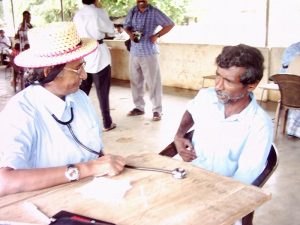
When female doctors were on duty, female volunteers also stayed within the hospital premises, working tirelessly day and night. Let me provide a couple of examples to illustrate the nature of their work.
At the Nainamadu Hospital, the doctor would often commute early in the morning by bus from his lodging, as there were no facilities for him to stay at the hospital overnight. On one such day, Dr. Thillainambi was traveling by bus when an emergency arose involving a pregnant woman who was also on her way to the hospital. She was at risk of delivering the baby imminently, causing panic among the passengers. Recognizing the urgency, Dr. Thillainambi introduced himself as a doctor, instructed the passengers to disembark, and, with the help of a few women, successfully delivered the baby on the bus, saving both the mother and child. Had he not been there, the situation could have ended tragically.
In another incident, a small child was brought to a hospital suffering from severe breathing difficulties caused by mucus blocking her airway. The hospital lacked the necessary equipment to clear her airway. The attending doctor, undeterred, used a simple tube, inserting it through the child’s nose, and suctioned the mucus out using his mouth, a task even the child’s mother hesitated to perform. This selfless act saved the child’s life and stabilized her condition.
Thousands of such stories form the history of these doctors. Another notable instance occurred at the Mangulam Hospital. A pregnant woman traveling on a motorbike—a common mode of transport in the region—was unable to continue the journey due to labor pains. Her husband rushed to inform the doctor, who promptly came to her aid. Unable to move her to the hospital in time, the doctor conducted the delivery under the shade of a tree near the road, saving both mother and baby.
Yet another example took place in Battalipuram in southern Tamil Eelam during a period of ceasefire breakdown. During this volatile time, a child accidentally swallowed an iron nail. When the mother tried to retrieve it manually, it was pushed further down. The child was taken to the Thileepan Hospital, which lacked the equipment needed for such emergencies. The doctor determined the child needed immediate advanced care at a government hospital, which was under military control. With no driver available for the ambulance, the doctor himself took on the task, despite the risks of entering a military-controlled area. He convinced hesitant companions to accompany him, stating, “I will drive; just show me the way.”
The journey was fraught with danger, as they risked being arrested or killed. However, the doctor prioritized saving the child’s life over his own safety. At a military checkpoint, the doctor fabricated reasons to pass through. After delivering the child to the hospital and ensuring their care, he managed to return safely, despite facing challenges at the checkpoints on his way back.
Such sacrifices were emblematic of the values instilled in the Thileepan Hospitals. The initial hospital was established in the village of Karisal in the Mullaitivu district, with Dr. Vasanthimala appointed as its first physician. Following this, additional hospitals were established in Kilinochchi (Poonakari), Vavuniya (Nainamadu and Puliyankulam), Mullaitivu (Alampil and Mangulam), and Mannar (Karukkaikulam and Mutharippu).
In the Jaffna district, hospitals were set up in Neduntivu (Nainativu) and Pungudutivu. In southern Tamil Eelam, hospitals were established in Battalipuram in Trincomalee, Kathiraveli and Kokkadicholai in Batticaloa, and Kanjikudicharu in the Amparai district.
The training of doctors for the Thileepan Hospitals followed a unique model, inspired by examples like Fidel Castro’s initiative during the U.S. embargo on Cuba. Castro trained barefoot doctors to serve rural populations. Similarly, Thileepan doctors were trained not only in medicine but also in various other skills required to live and work among the people as their friends, guides, and protectors.
The training was rigorous, overseen by esteemed professionals such as Dr. Ezhumathi Karikalan (commonly known as Dr. Andy) and Dr. Suryakumar. While many completed the training and became doctors, some did not succeed in the exams or left during the program. Those who graduated underwent additional training to ensure they could effectively serve the community in all aspects.
What kind of training was provided?
Training included Basic Medicine, Obstetrics, Basic Surgeries, and Political Training.
Political training? Why does a doctor need politics?
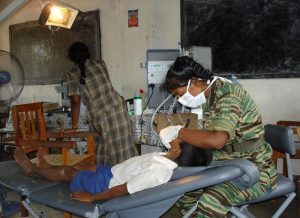
As I have mentioned before, having only medical knowledge was insufficient for a doctor working in our hospitals. This was something our trainers firmly believed in my case. As far as I know, globally, the Tamil Eelam government was unique in requiring doctors to work among the people with a clear understanding of politics. This was because we were individuals tasked with working closely with the people. We needed to understand them and learn various aspects required to align with them.
We realized that merely approaching people with medical knowledge might lead them to see us as outsiders. Therefore, we needed to develop comprehensive personalities to connect deeply with the people. For instance, when children had doubts in their studies or when adults faced minor family disputes, we resolved those issues ourselves. This built trust and closeness between us and the people. It was essential for us to prepare thoroughly because society is a complex entity. It comprises various customs, expectations, and practices, and working with them without knowledge of these would not have been easy.
To address this, new training sessions were initiated at the Thuyavan Political Science College. Mr. Umaianesan, the Head, Mr. Arasanna, the Principal, and Mr. Parimagan, the Administrative Officer, designed and conducted the curriculum. Apart from the principal and teachers of the college, experts from various fields acted as guest lecturers. Sessions were conducted by Justice and Administrative Officer Mr. Para, Tamil Eelam Police Officers, and others. Topics included psychology, maintaining public relations, caste issues, Tamil Eelam laws, police procedures, political awareness, understanding public problems, and solutions to these issues.
One significant class that had a profound impact on me was led by the principal of Thuyavan Political Science College, Mr. Arasanna, on the topic of caste in Tamil Eelam. This session gave me a comprehensive perspective on the caste values in our homeland and taught me how to break down the divide between high and low castes to build an egalitarian society. Until then, I had neither thought about caste nor had the opportunity to learn about it. However, as someone preparing to work with people, this class became a guiding light for me to solve many subsequent problems with ease.
Additionally, sessions were conducted by Mr. Reynold Adikalar, political analyst Mr. Master, and Father Kili. Among them, Father Karunaratnam Adikalar, affectionately known as Father Kili, taught about the superstitions of various religions, identifying which beliefs were credible and which were baseless, and how to dismantle them. He clearly instilled many insights within us regarding this. He demonstrated what medicine could achieve beyond religious boundaries and strengthened our convictions. Exams were conducted, and only after passing them were we considered fully trained doctors of the Thileepan Hospital.
What followed the training?
Along with these classes, we prepared ourselves and finally published a booklet titled “Sutrottaam” (Outreach). With the release of this book, our service to the people began. From my perspective, these training sessions were instrumental in helping me learn many aspects and mold myself into a better person.
Did the Thileepan Hospital operate as an independent unit?
Yes. Like other departments within the medical division, such as field medicine, healthcare, inventory, and procurement, the Thileepan Hospital operated as an independent unit. The first in-charge of the hospital was Mrs. Elumathi Karikalan. Although many heads changed over time, Mrs. Elumathi Karikalan resumed the role during the later stages. The Thileepan Hospital had its distinct identity, with its staff having a unique uniform and a dedicated operational management structure. However, no division worked in isolation during operations; all worked collaboratively.
What were the challenges in starting the Thileepan Hospital?
When we graduated from medical training, many questions arose. The most pressing issue was the shortage of medical supplies. At the time, the Vanni region faced severe economic and medical blockades. Obtaining medical supplies was a significant challenge. The medical division’s procurement and inventory departments fulfilled the hospital’s needs. Requests were made, approved, and fulfilled through the medical division’s warehouse. Medications allocated for fighters were extended to the Thileepan Hospital for public use, resolving this obstacle.
Another major challenge was the need for ambulances to transport patients requiring advanced treatment. Telling patients to arrange their own transportation was not feasible. Hence, there was a need for vehicles equipped with medical facilities.
How were these needs met?
They were met in various ways. For instance, while I was working in Pungudutivu, I met a member of the Pungudutivu Alumni Association in Canada named Arutprabha. After discussing the hospital’s needs and services, he returned to Canada and later contacted me to say he had discussed the matter with his organization. They approved funds for an ambulance for Pungudutivu. As a doctor, I could not handle the funds directly. I immediately informed the in-charge of the Thileepan Hospital and the Deputy Head of the Political Division, Mr. Thangan. Funds exceeding 3 million rupees (exact amount unknown) were sent from Canada. An ambulance was procured promptly, with inscriptions acknowledging the donors, and it was used for patient services in Pungudutivu.
Did the Thileepan Hospital only provide mobile medical services?
No, the Thileepan Hospital did not solely provide mobile medical services. It also operated as a hospital. There were approximately 12 locations where it functioned as a hospital and provided mobile medical services where needed.
What kind of services were provided?
Services included medical treatment, disease prevention, treatment for non-communicable diseases, awareness campaigns, educational programs for students, training on basic medical first aid, dental care, and physical health services. These activities were implemented among the people.
Even though this program was implemented by our doctors in all regions, I initiated this training program during my tenure in Pungudutivu. At that time, nearly 120 students were trained under this program in Pungudutivu. Upon the completion of the training, I had to conduct an examination for them and issue certificates. I organized the examination and distributed certificates. These certificates bore the signatures of the Deputy Head of the Tamil Eelam Administrative Department, the Head of Tamil Eelam Health Services, and the Jaffna District Health Services Director (Sri Lankan Government Jaffna District Director). The certificates were presented on the occasion of Thiyaga Theepam Dileepan Memorial Day, making them highly valuable. Subsequently, those trained worked under the title of Dileepan Hospital First Aid Volunteers, which brought the program to a successful conclusion.
Collaborations for First Aid Training
Later, during my tenure in Batticaloa, we collaborated with an international organization, Médecins du Monde (Doctors of the World), to conduct a similar training course and created first aid responders. There, too, we issued valuable certificates. These certificates were signed by the head of the non-governmental organization, the District Government Health Services Director, and the Director of the Dileepan Hospital, thereby establishing them as proficient first aid responders.
Similarly, in the Eastern Province, we formed a team of first aid responders, training approximately 75 individuals to become first aid professionals. For this program, the international organization Médecins du Monde (MDM), which was actively involved in medical services at that time, played a significant role. Not only did they take full responsibility for the program, but they also issued certificates that bore three distinguished signatures: on the right, the District Government Medical Director; in the center, a representative from Médecins du Monde; and on the left, the Director of the Eastern Province Thiyaga Theepam Dileepan Hospital.
About the Doctors Who Worked at the Thiyaga Deepam Dileepan Memorial Hospital
The doctors dedicated themselves fully to their work. Despite the shortage of resources, they effectively carried out their responsibilities to serve the people. They participated tirelessly in every task, working without rest, day and night.
How were disaster management operations handled?
A notable example is the response to the tsunami. We were always prepared to protect people during natural disasters. Most of our team members were field medic fighters, which meant that even the tsunami’s impact was not entirely unfamiliar to us.
When the tsunami struck, I was standing very close to the Mullaitheevu beach. Seeing people running and questioning them, they informed me that the sea had entered the village and swept many away. Rushing to the spot, I witnessed the devastation of the Mullaitheevu coast. Immediately, I began relief operations, evacuating the injured and providing first aid. While gathering the bodies of those who had passed away, we saw another massive wave approaching and moved to safety. After the second wave hit, the destruction in the Mullaitheevu area was so complete that nothing could be seen anymore.
From that location, the doctors from the Dileepan Hospital started working alongside the people as one of them. In the aftermath of the disaster, we collaborated with the Tamil Eelam health department, the medical division, and even government doctors to rescue the injured and address the loss suffered by the people. Months after the tsunami, we continued to engage in rehabilitation efforts to help the affected population recover.
A Memorable Incident in Maruthangeni
One unforgettable event occurred in the Maruthangeni area. A mother who had lost all seven of her children to the tsunami stood alone, on the verge of mental collapse. Understanding her fragile mental state, I spoke to her. Realizing she was still young and physically capable of having another child, I encouraged her not to lose hope. However, she lamented that after giving birth to seven children, she had undergone a sterilization procedure and deeply regretted it, expressing despair that she had no parents or the ability to have more children. Along with others, I worked to counsel her and restore her mental stability, successfully helping her return to a more normal state.
This is how the staff of the Dileepan Hospital, as well as those involved in the Tamil Eelam health and medical divisions, collaborated in their efforts.
Handling Epidemics
When dealing with epidemics, two primary strategies were followed:
- Identifying infected individuals and providing them with appropriate treatment.
- Implementing infection control measures to prevent the disease from spreading to others.
Our medical division excelled in both aspects, with numerous examples to prove it.
One significant epidemic we faced between 1995 and 1999 in Vanni was malaria. Our medical division achieved a major victory in eradicating malaria. Under the leadership of Dr. Sujandhan, along with Dr. Vickineswaran and Dr. Suriyakumaran, and a team of medic fighters, they created a malaria-free Vanni, achieving a state of “Malaria 0” within the areas under the Liberation Tigers’ control.
Similarly, there was the cholera outbreak. When the cholera epidemic struck, its effects were immediately recognized, and prompt actions were taken. The first patient was identified on Vidathalaitheevu Island. Dr. Suriyakumaran, accompanied by medic fighters like Thanikai and Priyavathana, collaborated with the government doctor stationed there and successfully controlled the outbreak, achieving a significant victory.
As I mentioned earlier, the moment the cholera outbreak was identified, the entire village of Vidathaltheevu was sealed off and brought under the control of the doctors. No one was allowed to enter or leave. Not only did they contain the spread of cholera within Vidathaltheevu, but they also investigated its origin and discovered that the disease had been carried from Puttalam in Sinhala territory.
Our doctors not only saved the lives of our people but also sent this information to the Sri Lankan government to help protect the Sri Lankan people.
Cholera Among Fighters
This deadly disease also spread among the fighters. Our medical division handled this situation effectively and successfully. When an entire unit operating in the forests of Trincomalee in southern Tamil Eelam was severely affected by cholera, including their medic, a fighter named Maruthan, the team of 100-120 fighters was left without any medical aid.
In response, a medical team with adequate intravenous fluids and supplies was sent from northern Tamil Eelam. While they managed to save as many fighters as possible, others requiring advanced treatment had to be urgently transported to northern Tamil Eelam. This task was efficiently carried out by the Sea Tigers. However, during the transfer, the Sri Lankan Navy intercepted and engaged in combat, leading to some fighters, already weakened by cholera, sacrificing their lives along with a few Sea Tiger fighters.
The remaining fighters were isolated and treated in eastern Mullaitheevu, where they were saved. While this operation was relatively routine, the significant aspect was how our medical division implemented disease prevention measures afterward.
From transporting the bodies of fallen fighters to their burial in seed pits, all involved were immediately vaccinated. Restrictions were imposed on fishing and access to the eastern Mullaitheevu coast. It was through such careful and detailed efforts that the land of Vanni remained free from epidemics.
Reflection on COVID-19 Measures
Looking at the current measures taken to prevent the spread of COVID-19, one cannot help but notice similarities with the actions of the Liberation Tigers. What are your thoughts on this?
Perhaps so, but our actions were always guided by the goal of protecting our people. In contrast, the Sri Lankan government is politicizing this situation. Our people must understand this.
The current government is trying to gain goodwill from the Tamil community to escape accountability for its past genocidal actions. It is distressing to see some of our people failing to recognize this. Many celebrate those who destroyed our race as saviors. But even now, they covertly perpetuate acts of genocide against Tamils.
A Critical Perspective
Consider this: Sri Lanka is an island. The only gateway to the outside world is its air travel. Colombo’s Bandaranaike International Airport is the central hub for international flights. How far is Tamil Eelam, where Tamils live, from this airport? Couldn’t a small patch of forest in southern Sri Lanka have been designated to isolate those coming from abroad as potential carriers of disease? Why was Tamil territory, hundreds of kilometers away, chosen for this purpose?
This mindset seems to be that even if an epidemic spreads, it should not affect the Sinhalese population but let the Tamils perish instead.
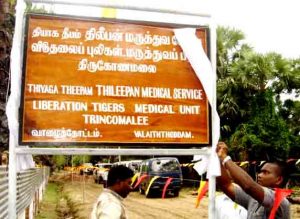
On Curfews
I do not deny that curfews help reduce the spread of infectious diseases. However, if the government truly cared for its people, such a critical situation would not have arisen in the first place. When the COVID-19 problem was raging in China, halting international travel would have prevented this emergency. Even now, it is unnecessary to impose curfews across all districts, causing hardships for people.
For instance, take Jaffna. It has only one or two main access roads, which can be sealed off. Curfews could then be implemented in Jaffna alone to prevent the spread of infection to other districts. Similarly, other districts’ borders could be secured with strict police or military measures to protect people.
In districts not affected by the virus, imposing curfews unnecessarily harms the population, especially daily wage workers and farmers, who face immense difficulties.
When cholera spread in Vidathaltheevu, we did not impose a curfew across all of Vanni. Instead, we contained Vidathaltheevu alone, yet Vanni was safeguarded.
On May 18, 2009 – The Day of Genocide
I have no words to describe this day. It was the day all our dreams were shattered. The day our ideals, for which we sacrificed everything, fell silent. The day our blood-soaked land, red with the sacrifices of martyrs for freedom, submitted to Sinhala dominance. It is a day that brings unimaginable pain.
When this battle began in early 2008 on the Vanni frontlines, I was working at the Neththangkaandal hospital. As the frontlines moved closer to our village, we relocated to several places, eventually arriving at Mullivaikkal. Even as our dreams gradually faded, and we were left in despair, I continued my duty as a doctor at the Dileepan Hospital until the very last day.
I transformed an ambulance into a makeshift surgical unit and, on May 17, 2009, performed surgeries on three injured individuals under a tree in Vattuvakkal. That was my final treatment. I still remember how Dr. Ezhamathi Karikalan stood by my side, fulfilling his duty.
When our Tamil Eelam national leader created us, he envisioned something that we fulfilled until the very end. Though our dreams have silenced, our memories and duties remain steadfast.
Translation by Hari